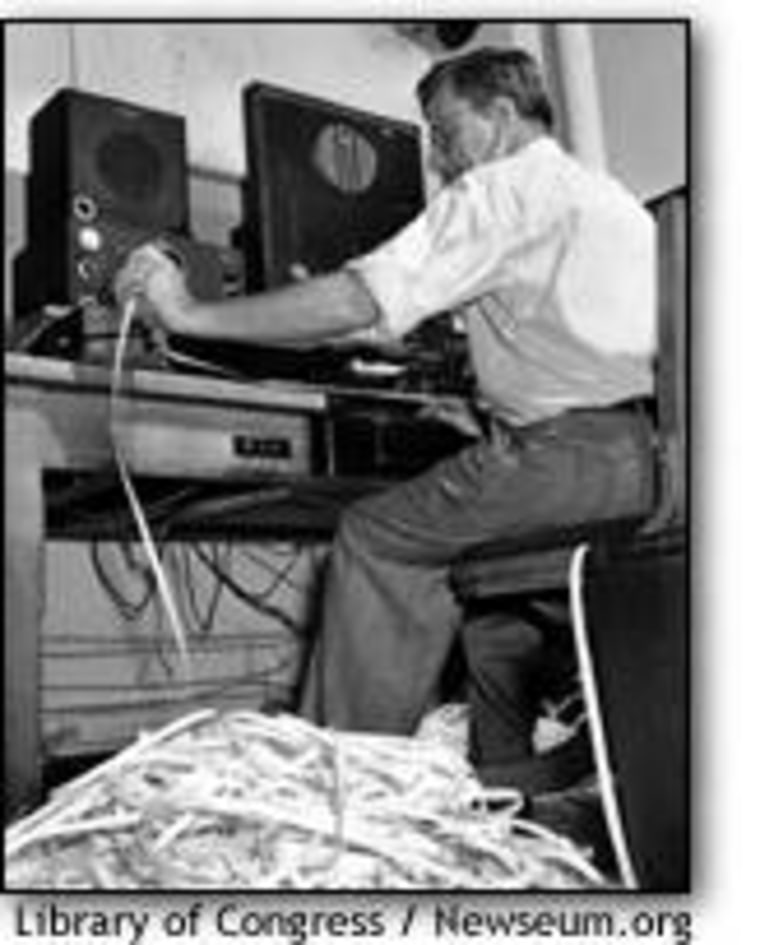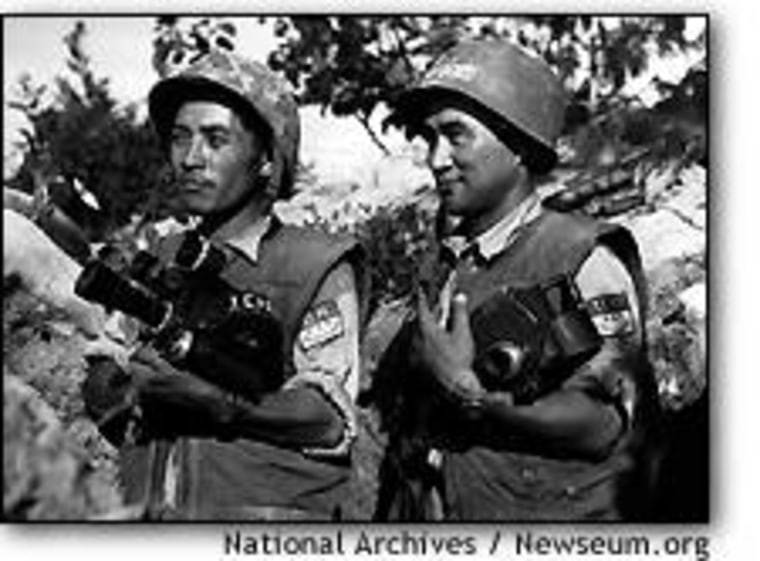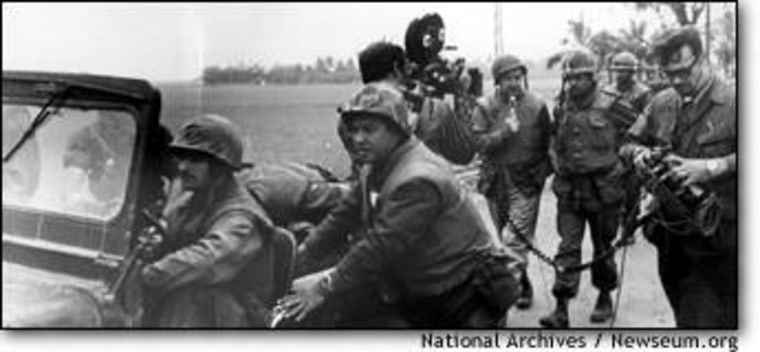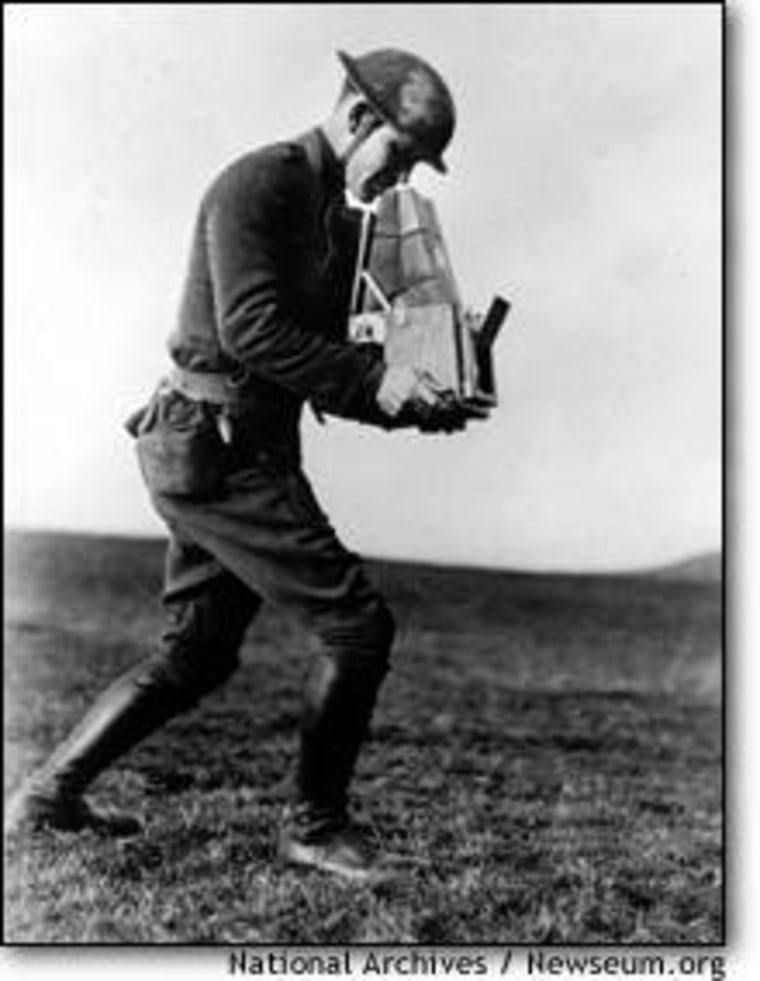First, a horseback messenger raced across the plains of Mexico and Texas, delivering the dispatch to the nearest steamboat. There, another messenger sailed for the closest big city with a telegraph. Then, George Wilkins Kendall’s latest dispatch was wired to New Orleans, where his newspaper, The Picayune, would publish it the next day. His reports from the Mexican-American War often beat the military dispatches sent back to commanders in Washington. It was 1846 and the electric telegraph was barely 10 years old, but Kendall’s resourceful use of the new technology began the love affair between war correspondents and gadgetry that has endured ever since.
It's hard for our speed-of-light, 24-hour-news society to imagine how shocking such recent war news was to Kendall’s audience. Today, when cable news watchers watch live cameras from Baghdad and learn of bomb blasts, viewers in the United States sometimes know about the explosions even before Iraqi citizens one mile away from impact. News travels around the world at the speed of light, but explosions travel only at the speed of sound.
It wasn’t always like this.
For centuries, war coverage meant hand-carried letters from the front that arrived weeks later. News traveled so slowly that much of the Battle of New Orleans was fought after the War of 1812 was officially over.
Three decades later, Samuel Morse and the telegraph changed everything. The world shrank instantly; war correspondents were suddenly hours away from their readers instead of days. When newspapers with the latest war stories flew off the racks publishers caught on, and soon, telegraph dispatches were commonplace.
Civil War: the telegraph
Kendall’s use of the telegraph now ranks only a short footnote in history, but it set the stage for Civil War newspaper coverage, which sometimes shocked the readers of the 1860s with timely accounts of battles that had taken place only a day or two earlier.
“Most of the battles weren’t far away from metropolitan areas,” said Don Ross, senior editor at The Newseum, an interactive exhibit of journalism artifacts funded by The Freedom Forum. “When the battle was over they would jump on their horse and go the to nearest city that had a telegraph. Any decent-sized town would have one. Anywhere there was a railroad stop, there would be a telegraph.”
But before Northern correspondents’ stories made it to their editors, they made a pit-stop — at the War Department Telegraph Office.
“Every single telegraph went through the Secretary of War’s office,” said David Mindich, chair of the journalism department at St. Michael’s College. “When (President) Lincoln wanted to get news about the war, he would go to (Secretary of War Edwin) Stanton’s telegraph.”
The amazing new technology had created a central funnel through which all news was sent, making the censors’ life easier than ever.
The Civil War was also the first U.S. war to be documented in photographs. But technology did not yet allow photographic reproduction in newspapers — only occasional engravings of photographs appeared. Those who viewed Matthew Brady and his company’s famous images did so mainly at gallery showings, Ross said. And photographs of combat in action were out of the question, due to the long exposure times required by the cameras of the day.
World War I: trans-Atlantic news
By 1914, when World War I began in Europe, technology advances had significantly improved both photography and newspaper production, and motion pictures, the telephone and radio had all been invented. But it was the laying of trans-Atlantic telegraph cables that really had an impact on war coverage, letting U.S. audiences read daily news from “across the pond” for the first time.
But British censorship was aggressive and when British agents cut Germany’s trans-Atlantic cable, the line in London was left as the only one connecting Europe and America. Once again, a central funnel for information made the censor’s life easy.
By the outset of the war, millions of American homes and businesses, including newsrooms, had telephones. But while the first transcontinental phone call took place in 1915, trans-Atlantic calls were still years away, so the devices were of little use to U.S. war correspondents abroad.
The most important advance in photography by World War I was that shooters no longer needed to cart entire darkrooms behind them into the battlefield. But severe censorship kept almost all non-military photographers away from the front lines, limiting visual coverage of the war. Most surviving images were taken by combatants, and were either controlled by the government or didn’t surface until after the conflict.
The government didn’t just control radio — the United States actually shut down what nascent radio service existed in the country once it entered the war in 1917.
World War II: ‘This is London’
But by the outset of World War II, two decades later, radio had exploded in popularity. Americans across the country sat in their living rooms, riveted by Edward R. Murrow’s rooftop reports of the Battle of Britain.
“This is London,” said Murrow in 1940, ushering in the era of live war coverage.

Backpack short-wave transmitters allowed radio reporters to report from the field, but such live reports were rare, according to broadcast historian Elizabeth McLeod. Most field reports — like audio from the invasion of D-Day — were recorded. That was partly to appease censors, and partly for practical reasons, McLeod said.
“You couldn’t risk your correspondent being killed live on the air,” McLeod said.
Often, sound bites were taped on a clunky 50-pound device called a wire recorder, which contained a reel of magnetic coated wire.
Photography also made its mark during the war. Joe Rosenthal’s image of the Iwo Jima flag raising is perhaps the most famous picture of all American war photography. But Rosenthal didn’t know for weeks that the picture had caused a stir, Ross said. In fact, photographers almost never saw their own work — they simply sent their undeveloped film via couriers back to military bases for developing.
But once developed, getting war images into daily newspapers across the country was much easier by World War II, thanks to the invention of the “photo wire.” Wire transmission of photography had been developed in the late 1920s, and perfected by Bell Labs in the 1930s. Rosenthal’s picture was transmitted through an AP PhotoWire line in Guam, and made it into newspapers around the country the next day.
But not every war saw such technological progress.

Correspondents covering the Korean War in the 1950s faced the challenge of operating outside the technology-rich West. Phone lines in Korea were scarce, severely hampering efforts to deliver the story home. In some cases, news was slower to get out of Korea than out of Europe during World War II.
And while the first nightly news broadcasts on TV were born in the late 1940s, by the early ’50s, there were still only 10 million sets in American homes, most in or near New York City. The only video available was from government sources and war coverage remained dominated by newspapers and radio.
Vietnam: The living room war
The Vietnam War changed all that as national nightly newscasts brought the combat right into American homes in the 1960s.
Regular correspondent reports were a fixture of the newscasts. But while AT&T launched the first retransmission satellite into orbit in 1962, correspondents still had to film their reports, and send the film away from the front for developing.

“Doing any TV reporting involved at least three people, all hooked by wires a lot of cables, and batteries,” Ross said. “Because of the weight of the batteries, you wouldn’t be carrying too many with you ... and you didn’t have many lengthy reports.”
Early in the war, it could take some 20 hours to get video from Vietnam to U.S. news desks, but satellite transmissions were used later in the war to cut the transportation time.
Faxes: the people's weapon
The worldwide proliferation of fax machines during the 1980s again changed the way journalism worked. In a precursor to the power of the Internet, faxes allowed simple one-to-many communication, turning anyone with the right hardware into a publisher. Suddenly, ordinary citizens inside the Soviet Union, East Germany and China could both organize their uprisings and then tell the world about them. Much of the early news about the fall of the Berlin Wall, the collapse of the Soviet Union, and the Tiananmen Square uprising came courtesy of fax machines.
“The news flow was able to sidestep the Chinese government,” said Mindich. “This is an example of the leveling effect of technology. China could not censor the news because many people had faxes ... It’s the opposite of Stanton’s system of making all telegraphs go through him.”
Gulf War and CNN
While the United States invaded both Grenada and Panama in the 1980s, press access was completely restricted and there was essentially no combat journalism from those conflicts. The next significant advance came in 1991, at the start of the first Gulf War.
What Edward R. Murrow did for radio in 1940, Peter Arnett and Bernard Shaw did for cable news fifty years later. TV viewers sat riveted as, for the first time, they watched a war begin on live television.
But while mention of CNN’s Gulf War coverage evokes images of instant global video storytelling, those memories aren’t quite accurate. In fact, the key to CNN’s success was decidedly low tech — and radio-like. Arnett, Shaw, and producer Robert Wiener had made arrangements with the Iraqi government ahead of time for a special “four-wire” line, essentially a dedicated, point-to-point phone line that didn’t require routing through normal telephone switching stations. So, when the local phone system went out, Arnett was still able to talk to CNN headquarters. Initially, viewers only saw still images of Arnett and Shaw’s faces, while they essentially talked to the world over a telephone line. The first live images of the war didn’t arrive until hours later.
Kosovo: Journalism goes online
The 1999 war in Kosovo saw the advent of the Internet war correspondent. MSNBC.com, Slate, Salon, and ABCNews.com all had Web-based journalists in and around Yugoslavia when NATO began its bombing campaign. Do-everything journalists like MSNBC.com’s Preston Mendenhall sent back everything from magazine-style feature stories to video packages from the war zone. Mendenhall even managed to score an online chat with notorious Serb paramilitary leader Zeljko “Arkan” Raznatovic.
The Internet also enabled media outlets to circumvent even the strictest government censorship. When upstart radio station B92 was temporarily shut down by the Yugoslavian government, producers began rebroadcasting over the Internet. Again, efforts to stop the free flow of information were foiled by a worldwide, inexpensive one-to-many distribution network.
Blogs and videophones
Satellite phones (think cell phones that work almost anywhere on the planet) were introduced in the first Gulf War. But they were bulky, unreliable, expensive and delivered only a scratchy audio signal. Useful for staying in touch, sure, but of limited utility for live, on-air reporting.
The technology got new life late in the 1990s, however, when sat phones were married to a laptop computer and a small video camera. When combined with better compression techniques, videophones allowed war correspondents to beam live video from anywhere.
They caught on like wildfire. Dozens of reporters filed stories from Afghanistan with the technology, and now hundreds are using all manner of contraptions to air live reports while traveling with U.S. troops on the move. There appear to be cameras everywhere in this war, even some behind the lines in Baghdad. Television networks can “go live” to anyplace a correspondent can get to; though much as radio reporters did during World War II, some Iraq War correspondents are still finding value in taped segments.
Meanwhile, Internet publishing has evolved since Kosovo. The proliferation of “blogs,” a sort of combination diary and personal newspaper, gives the world thousands of private perspectives on the war. There are even blogs written by members of the U.S. military, and one allegedly authored by an anonymous Baghdad resident.
“This is the democratization of information,” Ross said.
Holy grail of combat reporting?
The advent of the videophone-enabled war correspondent has ushered in yet another era of combat journalism — instant, visual access, all the time. For many observers of war correspondent technology, the videophone is the holy grail, finally allowing journalists to bring viewers as close as possible to the front lines, letting people see for themselves the war as it unfolds.
But there are hazards, too, said Mindich — we might in fact be too close to the action.
“We have opened up a great new window onto the war ... but we can be beguiled by these new windows,” he said. “That this technology affords us a new view is true, but we also might not have the context we need.”
But ultimately, Mindich said, he believes it was the invention of the videophone that ended the Pentagon’s heavy-handed treatment of journalists which began with the Grenada and Panama invasions and ended with the combat-zone blackouts of the Gulf War. Given the reality that journalists worldwide had the ability to make their own way into the Iraqi combat zone and beam pictures back to a variety of 24-hour news channels, the Pentagon had no choice but to invite journalists to the front lines this time, he said.
“There were hundreds of journalists out there who said, ‘Well, we’re we’re just gonna walk around Kuwait and Iraq with our technology,’ ” he said, leaving the Pentagon no choice. “Technology has leveled things a lot.”
